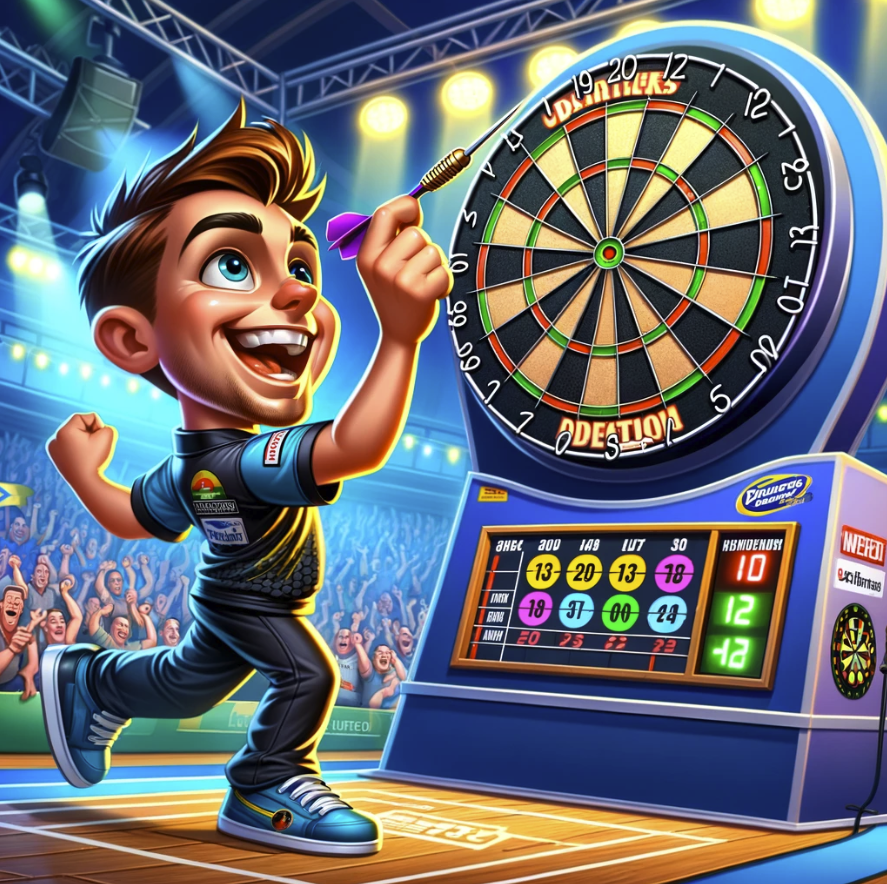Professional darts is a sport that combines skill, strategy, and precision.
Here’s a brief overview of how it works, focusing on scoring, strategy, and tactics:
Scoring
- The most common format is “501.” Players start with 501 points and aim to reduce their score to exactly zero.
- Players throw three darts per turn, and the score for each throw is deducted from their total.
- The outer ring scores double the number of the segment hit, and the inner ring scores triple.
- Hitting the bullseye scores 50 points (the outer bull is 25 points).
- To finish (“check out”), players must reach exactly zero by ending on a double or the bullseye.
Strategy
Starting the Game
Players aim to reduce their score quickly, often targeting high-scoring areas like the triple 20.
Middle Game
Players balance between aiming for high scores and setting up their finish.
Checkout Strategy
When nearing zero, players must strategize their throws to end on a double. There are ‘checkout tables’ that players memorize for efficient finishes.
Tactics
Accuracy and Consistency
Professionals practice hitting specific areas consistently.
Mental Game
Staying focused and handling pressure is crucial, especially in close matches or when aiming for a difficult checkout.
Adjusting to Opponents
Players may adjust their play based on the score and style of their opponent.
FAQs – How Does Professional Darts Work? (Scoring, Strategy, Tactics)
What are the basic rules of professional darts?
Professional darts typically involves players throwing darts at a circular dartboard fixed to a wall.
Each player takes turns to throw three darts. The objective is to reduce a fixed score, commonly 501 or 301, to zero.
The final dart in a game must land in a double segment or the bullseye.
Players are disqualified from a throw if they step over the line marked on the floor, known as the “oche.”
How is scoring done in a professional darts game?
Scoring in darts is based on where the dart lands on the board.
Each segment of the dartboard has a number, and hitting one of these segments scores that number of points.
The outer ring of the board is the “double” ring, where scores are doubled, and the inner ring is the “triple” ring, where scores are tripled.
The bullseye is worth 50 points and the outer bull is worth 25.
What is the significance of the numbers on a dartboard?
The numbers on a dartboard are arranged in a specific order to penalize inaccuracy.
High-scoring segments like 20 are flanked by low-scoring segments like 1 and 5.
This arrangement increases the risk-reward aspect of the game, as aiming for high scores can result in low scores if the dart is slightly off.
What does ‘501’ mean in darts?
‘501’ is the most common format of professional darts. It refers to the starting score of each player in a game.
Players must reduce their score from 501 to exactly zero, with the final dart needing to land in a double or the bullseye.
How do players win a game of darts?
Players win a game of darts by reducing their score to exactly zero before their opponent, with the condition that the final dart thrown must land in a double segment or the bullseye.
This is known as “checking out.”
What are some common strategies used in professional darts?
Strategies in professional darts include aiming for high-scoring segments (like triple 20) to quickly reduce the score, focusing on accuracy to consistently hit desired segments, and calculating the best combinations of scores to set up an efficient checkout.
Players also need to adapt their strategy based on their current score and their opponent’s performance.
How important is accuracy compared to strategy in darts?
Accuracy is crucial in darts as it directly affects scoring.
However, strategy is equally important, especially in deciding which segments to aim for to maximize scoring opportunities and efficiently plan checkouts.
A player with excellent accuracy but poor strategic planning may struggle to close out games.
What are ‘checkouts’ in darts and how do they work?
Checkouts are the final throws a player makes to reduce their score to exactly zero and win the game.
The final dart must land in a double segment or the bullseye.
Checkout strategies involve calculating the best combinations of scores to efficiently reach a double that can be hit with the final dart.
Are there different types of dartboards used in professional play?
Professional darts primarily uses bristle dartboards, which are made from sisal fibers.
These boards are preferred for their durability and self-healing properties.
Electronic dartboards are used in soft-tip darts, but they are less common in professional leagues.
How do professional darts players practice and prepare for tournaments?
Professional darts players practice extensively to improve their accuracy and consistency.
They also study different checkout combinations and practice under conditions simulating tournament environments.
Mental preparation is also key, as players need to handle pressure and maintain focus during matches.
What are sets in professional darts?
In some professional darts matches, games are played in sets.
Each set consists of a number of legs (individual games).
A player wins a set by being the first to win a predetermined number of legs.
The overall match winner is the player who wins the most sets.
This format is commonly used in prestigious tournaments like the PDC World Championship.
How far away from the board do they stand in professional darts?
In professional darts, players stand at the “oche,” a line marked on the floor, which is 7 feet 9.25 inches (237 cm) away from the dartboard measured horizontally.
This distance is standard in darts competitions worldwide.
Conclusion
In professional darts, every throw counts and a slight misaim can change the course of the game.
Players must be adept not only in throwing darts with precision but also in quick mental arithmetic and strategic planning.
Related
